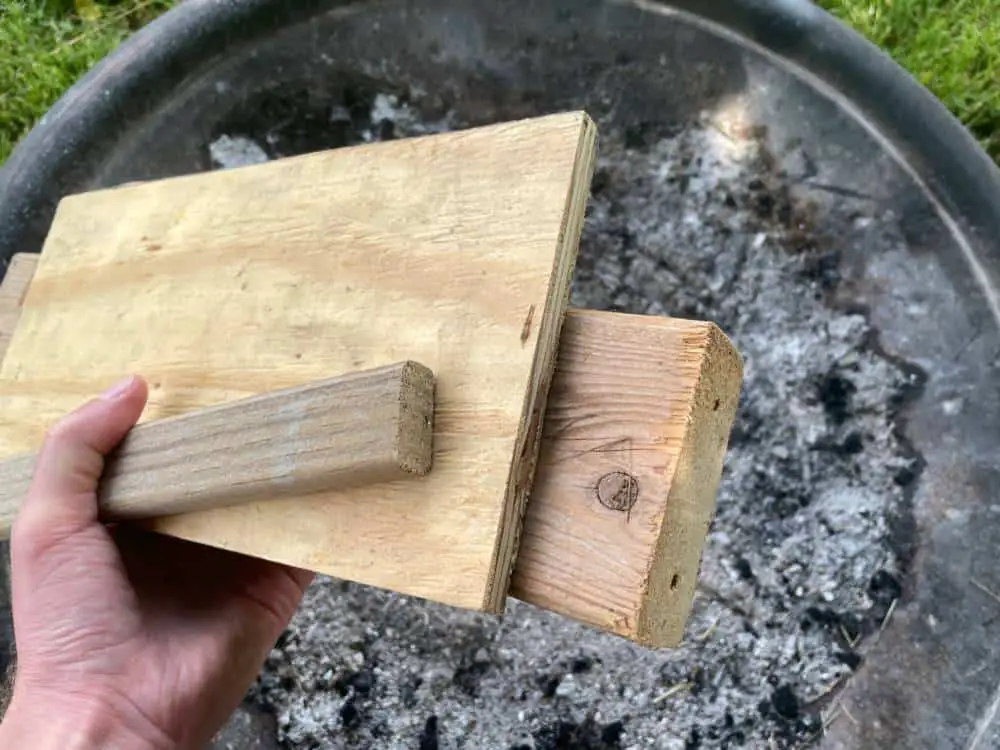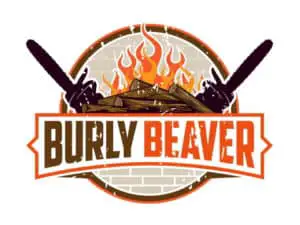If you’ve got some extra 2×4’s or other scrap lumber lying around, it’s super tempting to just to chuck it into a fire.

You get rid of the wood, and you get a good fire. Sounds nice.
But, is it actually okay to burn scrap lumber?
You should not burn scrap lumber if it is treated, stained, or painted, because this will release toxic fumes into the air. It can also be dangerous to burn plywood, because of the adhesives it contains. However, some lumber is untreated and is comprised only of natural wood, this can usually be burned safely.
Now, you’re probably here because you’re considering burning a specific piece (or pile) of scrap wood, so should you burn it? And how do you tell if it’s treated? That’s what we’ll dig into in the rest of this article. Let’s get to it!
- 3 Reasons Not to Burn Treated Lumber
- 5 Ways to Tell if Wood is Treated
- Can You Burn 2×4’s
- Can You Burn Scrap Wood at a Campsite?
- Can You Burn Pallet Wood?
- Can You Burn Plywood?
3 Reasons Not to Burn Treated Lumber
Let’s begin by briefly summarizing the 3 main reasons you should never burn lumber that is treated.
1. It’s Toxic (And Can Literally Kill You)
The most obvious reason not to burn treated lumber, is the toxic fumes that are released.
There are 3 main types of lumber treatment used today, including ACQ, Borate, and Non-Com. You don’t really need to know the details of each of these treatments, but non of them should be burned. In addition to these 3, there is an additional treatment called CCA, which was used in a lot of treated lumber produced prior to 2003.
CCA is the worst kind of treated lumber when it comes to toxicity. The “A” in CCA literally stands for “Arsenic”, which (as you may know) is super toxic. Now, you may be wondering HOW toxic it really is. So, to put things into perspective, here’s a quote about CCA lumber from the Montana Council of the BSA:
“A single 12ft x 2in x 6in board has enough arsenic to kill 250 adults.”
That’s obviously very bad. Don’t burn treated lumber.
2. It’s Illegal
The first point was probably enough to convince you not to burn treated lumber, but for the sake of being thorough, it’s also good to know that it’s also illegal to burn treated lumber.
So, it can hurt or kill people, and it can also lead to trouble with the law.
Burning treated lumber = bad.
3. You Don’t Need To
Finally, I thought it was worth pointing out, that you don’t NEED to burn treated lumber. If you need something to burn for a campfire or fireplace, there are plenty of safe alternatives. And since a lot of lumber is made from softwoods, you can probably find much hotter and longer burning firewood alternatives anyway.
And if you need to simply get rid of scrap treated lumber, then you can probably take that lumber to the local landfill in your area for proper disposal. Local landfills often have a website or phone number you can use to contact them, and you can use that to double-check that they can dispose of your scrap wood.
5 Ways Tell if Wood is Treated
Now that we’ve covered WHY not to burn treated lumber, you’re also going to need to know how to tell if wood is treated in the first place.
1. Look for a Sticker / Tag
Let’s start simple. Probably the easiest way to tell if a particular piece of wood is treated, is to check the end grain for a sticker. The sticker/tag would often be stapled on, and sometimes includes specific details about the wood, which could include the brand/manufacturer, the treatment that was used on the wood, and/or how much treatment was used on the wood. There’s a good image example of that here.
If the sticker doesn’t specifically say whether the wood is treated, you may still be able to figure it out, using the other information provided on the sticker. For example, if you bought the wood at Home Depot or a similar retailer, you may be able to identify the specific type of wood you bought using their website (or calling in to the store) and providing the information on the sticker.
This won’t work in all cases, and since you’re dealing with scraps, you often won’t have these tags available.
2. Look for a Stamp
If there’s no tag to go by, then the next most straightforward way to tell if your wood is treated, is to check for a stamp that’s been imprinted on the wood itself. If you find a stamp, look for the following markings:
- L P22
- L P2
- FDN
- Bor
All of these markings would mean that your wood is treated and should not be burned.
Also note, that this is not necessarily a comprehensive list, so there’s a chance you would encounter another stamp that indicates treated lumber which is not mentioned above. However, if the stamp does contain any of the above marks, you can be confident that it IS treated and should not be burned.
3. Ask the Buyer
In some cases you can also just ask the buyer of the lumber whether it is treated.
And if you bought the wood, you might remember if it was treated or not. Or, you might have kept the receipt, and you can check there for indicators. The receipt may mention if the wood was treated, or it might have an ID number that you can use to look up the lumber online.
If someone else bought the wood, then you can also ask them. They may know off the top of their head, but you will also need to make a judgement call on whether or not the buyer is a reliable source (e.g. do they understand the difference, or is it possible that they would get things mixed up?).
4. Examine the Color
You may have heard of this method before. This is actually the first way that I learned to identify treated lumber when I was a kid.
Treated lumber will often have a greenish tint or coating. Examine the wood closely, and if it has some green on it, then there’s a pretty good chance that it is treated. This method isn’t as accurate as the previous options, but it can still work. If your wood has a green color, markings, or if the color looks “unnatural” then there’s a pretty good chance that it has been treated and you should not burn it.
However, not all treated lumber will be easy to identify using the color, so it’s best to use more scientific methods (like those above) or to at least pair this method with another test.
5. Smell the Wood
Another test that you can use without any stamps or tags on the wood, is to simply smell the wood. When wood is treated, chemicals are added to the mix, and the process often changes the scent of the wood.
If you compare the smell of a piece of untreated wood to a piece of treated wood, then the treated wood will often smell like chemicals, whereas the untreated wood will smell more natural, like a woodshop or campfire.
Again, this method is not very scientific, so there’s a higher risk of inaccuracy compared with more direct indicators (like the stamps or tags).
What if You’re Not Sure?
If, after all of these checks, you’re still not sure if your wood is treated or not, then you should play it safe and not burn the wood. At the end of the day, it’s better to waste a little bit of wood, rather than risk putting arsenic or other harmful chemicals into the air.
So, now that we’ve covered these basics, let’s summarize a few things:
Can You Burn 2×4’s?
You can generally burn untreated 2×4’s and other scrap lumber without any issues. However, you must be sure that the wood isn’t treated, stained, or painted, because burning wood with these properties can pose serious health risks.
This applies to home use of the wood, but if you’re traveling or planning to use the wood at a campsite, then there may be other restrictions to keep in mind.
Can You Burn Scrap Wood at Campsites?
Even if your wood is untreated and safe for burning, you may not be able to burn it at campsites for a couple of reasons. First, burning scrap wood is against the rules of some campsites. And second, there are state and local restrictions about moving any type of firewood, in order to prevent the spread of invasive species’ like the Emerald Ash Borer.
Can You Burn Pallet Wood?
Pallet wood can be safe to burn if it has not been painted, colored, or treated with chemicals like Methyl Bromide, and assuming that it hasn’t absorbed any harmful substances from spills. However, any pallet wood that has been treated or exposed to any kind of spill, could be hazardous and should not be burned.
Methyl Bromide is the main chemical treatment that has been used to treat pallets in the past. And pallets will often be stamped with “MB” or another symbol if they have been treated. You can refer to this article to learn more about the different symbols and treatments used on pallets.
It’s also a good idea to examine the pallets for stains, or any other indicators, that would suggest a spill. Pallet wood can absorb nasty stuff from spills, even if it hasn’t been treated and stamped.
And, at the end of the day, you should always play it on the safe side. If you’re not SURE that your pallet wood is untreated and safe, then you should not burn it.
Can You Burn Plywood?
As a general rule, you should not burn plywood, because the adhesive that’s used to hold the wood particles together can release dangerous fumes when burned. If you have plywood that can’t be used for another purpose, you can take it to a local landfill for proper disposal. Don’t burn it.
